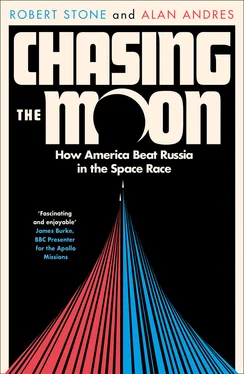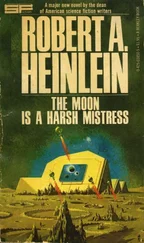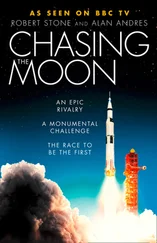Von Braun was also celebrated in American public schools, many of which had recently introduced new audio-visual equipment into the classrooms. The Disney studio actively licensed 16mm exhibition prints of “Man in Space” as an entertaining teaching aid. Disney published a teacher’s study guide to use in conjunction with the screening, which featured von Braun’s photo on the cover and suggested classroom discussion questions such as “How likely is it that the present barriers between nations will tend to break down as contacts with other planets develop?”
Von Braun’s onscreen presence in the Disney programs coincided with his appearance in another far less visible film. Released in late 1955, the low-budget black-and-white Department of Defense film Challenge of Outer Space recorded an “officers’ conference” in which von Braun addressed a classroom of officers from various branches of the armed services. The content of his presentation paralleled the Disney films—and even included Collier’s illustrations. However, von Braun approached it almost entirely in terms of Cold War military superiority, something that was never mentioned in the “Man in Space” program. When discussing his space station, von Braun described it as something of “terrific military importance both as a reconnaissance station and as a bombing platform” with “unprecedented accuracy.”
Seated in front of an American flag, von Braun answered rehearsed questions from the officers, such as “Dr. von Braun, can you explain why it would be easier to bomb New York from a satellite than from a plane or a land-launched guided missile?” His response to such sobering questions was in marked contrast to his demeanor in the Disney production. He didn’t resort to colorful language to appeal to his listeners’ sense of wonder or innate desire to explore the unknown; there were no mentions of a “Columbus of space” or allusions to humanity’s evolutionary leap when first entering the cosmos. From his past experience, von Braun well knew that delivering his message to a room of grim-faced men wearing campaign ribbons necessitated very different rhetoric. He framed his talk entirely in terms of adversarial conflict and achieving strategic advantage and concluded with a note of warning: “The Russians are already hard at work, and if we are to be first, there is no time to lose.”
IN THE SPRING of 1955, the Eisenhower White House approved a proposal for the United States to orbit the world’s first satellite during the upcoming scientific International Geophysical Year. Modeled on International Polar Years of the past, the IGY would involve scientists from forty-six countries taking part in global geophysical activities and experiments from July 1957 through December 1958. The Soviet Union was believed to be on the verge of announcing its own satellite program, so the United States was attempting to stake its claim as well.
Very real Cold War concerns lay behind what appeared to be a purely scientific initiative. Since the beginning of the escalating nuclear-arms race, the two superpowers had been seeking a method to monitor the progress of their opponent’s weapons programs and their compliance with international agreements. Rather than using a high-altitude spy aircraft, which ran the risk of being shot down, the influential global-policy think tank, the RAND Corporation, proposed a space-age alternative: an unpiloted orbiting observational satellite that would either transmit video images or return exposed film reels via automated reentry capsules.
President Eisenhower believed that if a scientific research satellite was placed in an orbit that passed over the airspace of a Soviet Eastern Bloc country, this action would establish a precedent for orbital overflight, thus opening up space for observational reconnaissance. But from a diplomatic perspective this was an unsettled matter of international law. Eisenhower listened to other advisers, who cautioned that if the United States became the first to orbit an object over another nation’s sovereign territory, it risked international condemnation. They thought it wiser for the United States to hold off being first.
Von Braun’s secret Project Orbiter proposal was vying against two alternative plans, developed by the Air Force and the Navy. Orbiter was generally acknowledged to be the most sophisticated, practical, and reliable of the three proposals, but it was the Naval Research Laboratory’s Project Vanguard that got the official nod in late July 1955 when the White House made its announcement. (The projected launch wouldn’t occur until late 1957 or 1958.) Von Braun believed Project Orbiter had lost out to the Navy specifically because he had been involved. He wondered whether professional jealousy, his recent celebrity status, and prejudice about his German past, combined with the ever-present interservice rivalry, had contributed to his satellite’s rejection. Von Braun was so sensitive about reports of antagonism against him in Washington that when he learned that Disney’s publicists were planning to promote a rebroadcast of “Man in Space” with an ad line suggesting that the TV show led directly to the White House’s recent action, he vehemently implored them not to do so, fearing that some in Washington would assume he was using his Hollywood connections to take credit. “The statement would hurt the cause far more than it would help,” he told Disney’s producer.
In fact, a more important factor was involved in the selection. Giving the project to the Naval Research Laboratory was intended to deemphasize military and strategic implications, since the lab already had a reputation for conducting basic scientific research, unlike the Ordnance Guided Missile Center at Redstone Arsenal. The Navy planned to use modified research rockets with an established pedigree from past scientific-research experiments. In contrast, the Army intended to use a modified Redstone, which had been expressly developed to carry a nuclear explosive.
A memo written by Eisenhower’s secretary of defense, Charles Wilson, clarifying the nation’s missile-development responsibilities, only made matters worse for von Braun’s team. Wilson gave the Air Force responsibility for all future land-launched space missiles and limited the Army’s work to surface-to-surface battlefield weapons with a range of less than two hundred miles. At Redstone Arsenal and in the city of Huntsville, morale plummeted.
Four days after the White House’s announcement of Project Vanguard, Soviet space scientist Leonid I. Sedov addressed reporters at his country’s embassy in Copenhagen, where the annual congress of the International Astronautical Federation was being held. Much as the White House had expected, Sedov announced that the Russians would possibly launch a satellite in the next two years. When asked by a journalist about any German rocket specialists employed in Russia, Sedov adamantly insisted that none were working there.
Sedov’s assertion was largely correct, despite published rumors to the contrary. The full story didn’t emerge for decades. Joseph Stalin had personally authorized that nearly five hundred of the remaining rocket engineers from Peenemünde be forcibly transported to Russia in 1946. They were confined to isolated communities with little more than standard amenities, where they were subject to constant surveillance and the enmity of their Russian counterparts.
The Soviet Union’s closest equivalent to von Braun was Sergei Korolev, a Ukrainian-born engineer and strategic planner who, despite having spent six years in one of Stalin’s gulags, had risen to prominence as the chief rocket designer. Korolev distrusted the German engineers living in Russia, fearing that if they attained positions of importance they could possibly thwart his own ambitions and undermine the authority of his handpicked team of designers. Nevertheless, by the mid-1950s, and after wasting years working on projects of little importance, most of the captured Germans were finally allowed to return to the West.
Читать дальше












